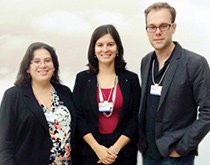Jessica Hammer felt socially awkward around her fourth-grade classmates, but when she started planning boutique birthday party games for some of them, suddenly she no longer felt alone. As she grew up, she never lost sight that games are about more than winning. Today, she studies, teaches, and designs games—striving to pack as much meaning into them as possible, be it on a screen or on a board.
“I want people to transform their willingness to learn,” says Hammer, assistant professor in CMU’s Human-Computer Interaction Institute and the Entertainment Technology Center. “I want them to experience it as participatory rather than didactic, as a joy rather than an obligation.”
 Also in the HCII, Assistant Professor Chris Harrison scrutinizes the world’s most modern technology and still considers most of it “primitive.” For instance, he envisions a computer mouse that is operated by your eyeballs, or a smartphone whose buttons are implemented via your skin. “I encourage my students to challenge everything,” he says. “Even when things are good, I ask them and myself, ‘How can it be better?’”
Also in the HCII, Assistant Professor Chris Harrison scrutinizes the world’s most modern technology and still considers most of it “primitive.” For instance, he envisions a computer mouse that is operated by your eyeballs, or a smartphone whose buttons are implemented via your skin. “I encourage my students to challenge everything,” he says. “Even when things are good, I ask them and myself, ‘How can it be better?’”
CMU associate professor, Inês Azevedo, contends that it may be in Pittsburgh, instead of sunnier locations such as San Francisco that you would install the next solar panels. Why? The co-director of the Center for Climate and Energy Decision-Making understands that it’s important to reduce conventional air pollutants and greenhouse gases in already compromised regions, which means not just harnessing the sun’s energy where it’s the most convenient, but also where you can derive the largest health and environmental benefits.
Their respective approaches in their fields have led to their selection to the World Economic Forum’s 2014 Young Scientist Community. Just 30 scientists were chosen, and Carnegie Mellon, with three, had the most representation of any institution worldwide. The Young Scientists participated in the WEF’s Annual Meeting of the New Champions 2014, in Tianjin, China.
—Elizabeth Shestak (DC’03)



